

Table of contents
- variety selection
- Location
- substrate
- planting
- Pour
- fertilization
- climbing aid
- Cultivate aerial roots
- Cut
- multiply
- repot
- diseases and pests
The Monstera is also called window leaf, which is due to its openwork leaves, which are vaguely reminiscent of windows. The plant originally comes from the tropical regions of South America. Due to its low demands, it is well suited for people who have little experience with houseplants or do not have much time to take care of a plant.
variety selection
The wild form Monstera deliciosa is mainly offered commercially. It is the original form of this species, but there are other cultivated forms that differ in growth and leaf color. The following varieties are available:
- Borsigiana: compact growing
- Albovariegata: variegated
- Variegata: creamy white leaf pattern
In terms of care, all varieties should be treated equally.
Location
Monstera grows on trees in the tropics. She is sheltered from the sun under the canopy of leaves. She should also be offered similar conditions indoors. It is particularly important that it does not get direct sunlight, as this can damage its leaves or stalks. harm their development. This makes it suitable for greening rooms in which there is no or there is hardly any daylight, such as anterooms or bathrooms. The ideal location should look like this:
- bright location
- no direct sun
- Temperature: ~ 20°C
- high humidity
Tip:
If the window leaf is on a cold tiled floor, at least a coaster should be used. Alternatively, a wooden board can also be used as an insulating layer.
The right location is particularly important for young plants. They are very sensitive to direct sunlight. Older plants are a bit more robust and can tolerate direct sun for a limited time. However, they should not have a permanent place in the sun either. In summer, however, the plants can be placed outdoors without any problems. A shady balcony or the north side of a house is ideal.
substrate
The window leaf has a strong growth and can reach considerable proportions. The development is favored by the right substrate. This consists of:
- 1/3 leaf soil
- 2/3 compost soil
- some perlite or coco hum
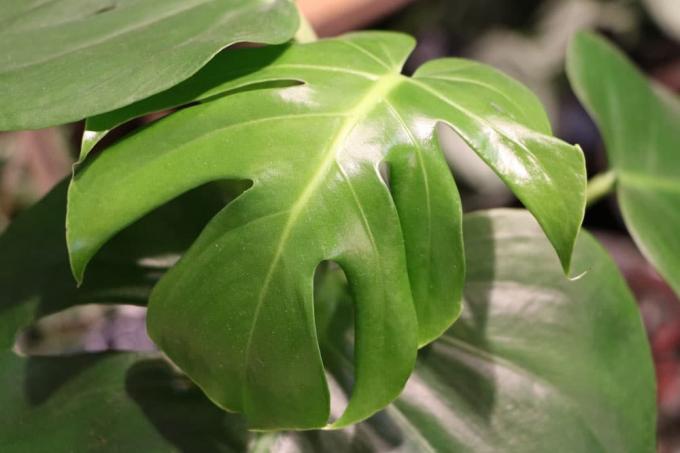
- expanded clay
- quartz gravel
- vermiculite
If gravel is used, it must be ensured that it is actually quartz gravel. For example, if the gravel contains lime, this can harm the plant, as it does not like calcareous soil.
planting
The window leaf has a strong growth, which is why a much larger container should be chosen when planting. A drainage is placed in the vessel as the bottom layer. This can consist of potsherds from broken pots or gravel or gravel. expanded clay used. Then some substrate is filled in and the plant is used. The pot is filled with the rest of the substrate up to the pouring rim. However, it is important that the aerial roots are not accidentally planted.
A notice:
In hydroponics, there is no drainage layer. However, material of different coarseness can be used, with coarse-grained substrate forming the lower layers and increasingly finer substrate being filled towards the top.
Pour
The window leaf requires high humidity. Therefore, not only should the substrate be moist, but the leaves should also be moistened at regular intervals. To do this, they can be wiped with a sponge or sprayed. Many simply place the plant in the shower and rinse it off with lukewarm water. On a rainy day, the window leaf can also be placed on the balcony. However, as soon as the blazing sun shines on the balcony again or it gets too cool, the plant has to be brought in again.
Tip:
Indoors, the humidity can be increased with humidifiers. Alternatively, a container with water can be placed on the radiator in winter.
To increase the humidity in the immediate vicinity of the window leaf, the plant can be placed on a saucer on a slightly raised pedestal. Clay granules are placed in the coaster and then the bowl is filled with water up to the brim. This is significantly less time-consuming than spraying the plant regularly or wiping the leaves.
When casting, the following should be considered:
- water only when the surface is dry
- use low-lime water
- Avoid waterlogging
Although the window leaf is native to the humid tropics, it does not tolerate waterlogging. This can cause the plant to rot.
fertilization
From spring to autumn, the window leaf is supplied with liquid fertilizer every two weeks. A commercial fertilizer for green plants is sufficient for this. Fertilizer sticks for green plants can also be used as long-term fertilizer. In the winter months, the plant also needs a resting phase. The fertilizer doses are also reduced. From about October to February, liquid fertilizer is used at most every four weeks.
climbing aid
In nature, the window leaf climbs up branches and trunks. To do this, it uses its numerous aerial roots. When cultivating in a pot, the Monstera therefore absolutely needs a climbing aid or a climbing aid. a prop. Otherwise, older plants in particular with very large and heavy leaves can break off.
The following materials are suitable as climbing aids:
- bamboo sticks
- moss sticks
- bamboo trellis
- Trellis with coconut filling
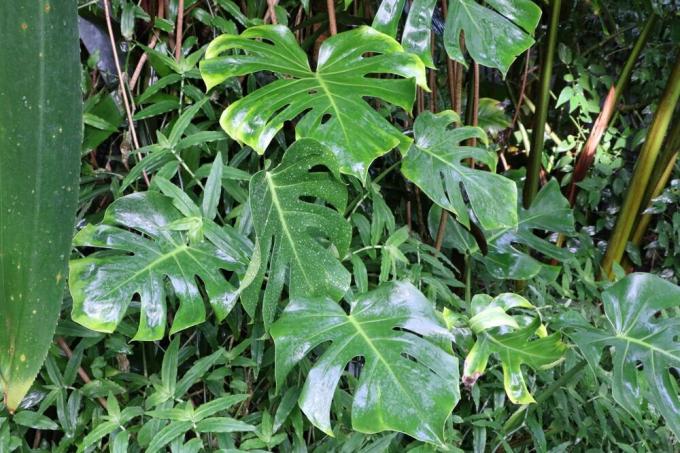
Basically, rods and grids with a rough surface should be used as climbing aids, because this is the only way for the aerial roots to find a good hold. A normal branch can also be used as a climbing aid. Smooth surfaces, such as bamboo sticks, should be wrapped with natural materials such as moss.
Cultivate aerial roots
The aerial roots are an essential part of the plant that are vital to it. They not only serve as an adhesive organ, but also supply the plant with nutrients and water, which is absorbed in the form of humidity. The aerial roots are very delicate and can easily break. The aerial roots can become very dominant and sometimes unsightly. However, you must not cut the aerial roots of the plant, as this can cause lasting damage. Unwanted aerial roots are carefully planted in the ground instead.
Tip:
For a limited time, the aerial roots can be placed directly in the water. As a result, the plant survives a longer period without being watered, such as when you are away for a long time on vacation.
Cut
Except for the aerial roots, the window leaf is very tolerant of pruning. You can easily cut the window leaf into shape, which is sometimes necessary due to their size, which can be up to three meters. You can cut back the plant with a sharp knife. The cut on a leaf is made about 10 cm above where it grows on the stem and should be straight.
If it is necessary to cut the plant radically, this is also not a problem. You can even cut back the main shoot without any danger. When cutting back very strong plant parts, however, they should be treated with a wound sealant to be on the safe side. The formation of pathogens is favored above all in damp rooms such as bathrooms due to the higher humidity.
Tip:
Instead of a commercially available wound sealant, charcoal ash can also be sprinkled on open wounds.
multiply
When cutting back, it is not uncommon for material to be produced with which the Monstera can be easily multiplied. Side shoots in particular are ideal for using them for propagation. A shoot should consist of two leaves and several aerial roots. If a shoot has not yet formed roots, it can also be placed in a container with water. If the water is changed regularly, the first roots will form within a few weeks.
The rooted offshoots are potted. It should be noted that at least two to three aerial roots should also be above the ground. Then it is poured and a transparent plastic bag is put over it. Where is prevented from losing too much moisture. However, the bag has to be lifted every two to three days to air it out. Otherwise, mold or rot may develop. In addition to propagation via cuttings, young plants can be grown via seeds. Under very good conditions, the window leaf develops a stalk flower with many small seeds. When propagating by sowing, the following must be observed:
- Fill the seed tray with potting soil
- moisten soil
- sowing depth approx. 1 cm
- Cover the seed tray with a transparent cover
- Germination temperature: 20° – 23°C
- Germination period: 2 - 6 weeks
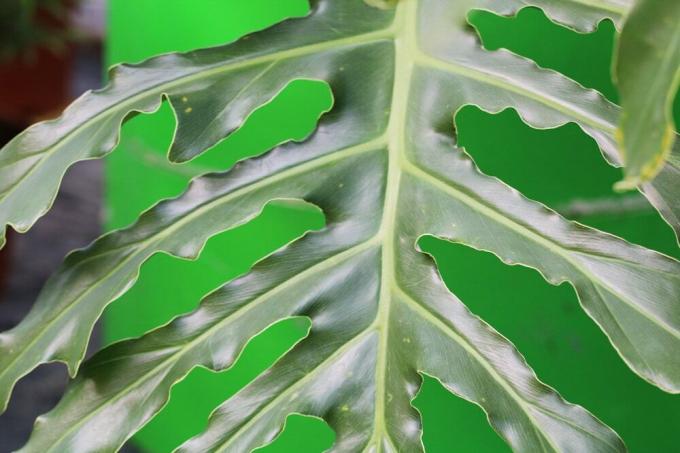
repot
If the window leaf is still very young, it should be repotted every year. This promotes healthy and vigorous growth. Even if you repot every year, you should always choose a container that is significantly larger than the previous one. The window leaf has a very strong growth and can become too big for the pot within a year. For older plants, moving them to a larger pot every three to five years is sufficient. However, the top 3 cm of soil should be removed every year and exchanged for a fresh substrate.
diseases and pests
The plant is not only easy to care for, it is also resistant to pests and diseases. Only scale insects and spider mites can become a problem for her. An infestation usually occurs when pests are brought into the house via new plants. If the plant stays indoors only, this can promote an infestation. In summer, the Monstera can be placed on a shady balcony or terrace. This also makes maintenance easier. However, if a pest infestation occurs, the following remedies have proven their worth:
- Repeatedly shower plants or put them in the rain
- Scrape off scale insects
- Encourage lacewing larvae or hatchlings as natural enemies
- use systemic insect repellents in severe infestations
The window leaf should be checked regularly for pests. A warning sign is also when growth stagnates or stunted leaves form. In addition, an infested plant must be isolated from other indoor plants.
 garden editorial
garden editorial I write about everything that interests me in my garden.
Learn more about houseplants
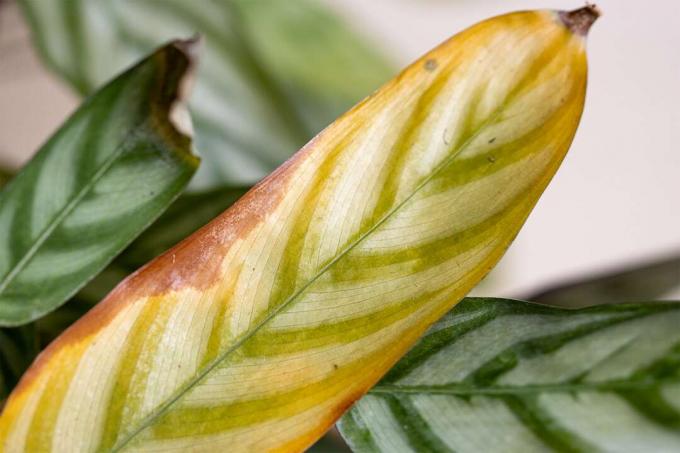
Calathea has yellow leaves: how to save?
When a Coriander (Calathea) gets yellow leaves, the cause is usually a lack of care. In order to save them from dying, a number of countermeasures must be taken, which are described in detail here.

Room bamboo: 13 tips for care
The room bamboo impresses with its compact growth habit and is a densely grown houseplant. The ten most important tips for caring for the sweet grass are compiled for you here.
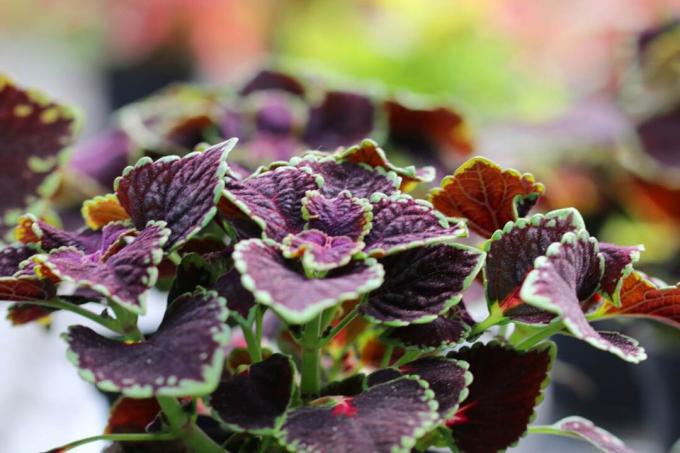
Coleus blumei: 21 tips for the red nettle
The colored nettle is a warmth-loving and easy-care foliage plant. The coloring of the leaves varies from monochromatic to variegated with a wide variety of drawings. Spectacular splashes of color can be set in beds, balcony boxes and tubs or as a houseplant.
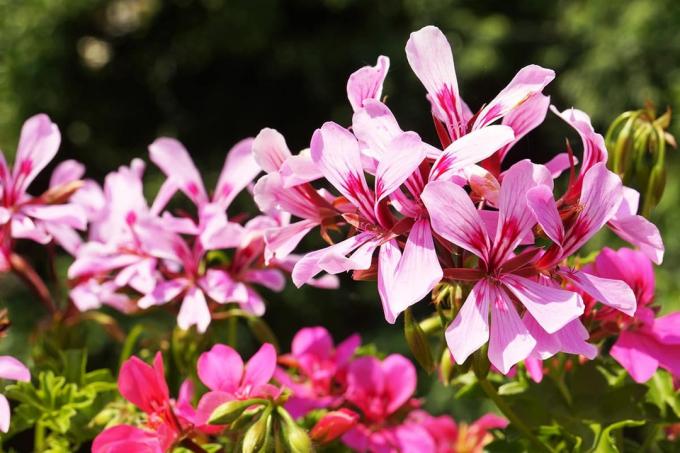
Scented houseplants: 25 scented plants for the home
An apartment without indoor plants is hardly conceivable. Scented plants in particular have a very special effect. Not only are they decorative, they can lighten the mood and rival any artificial home fragrance.

Lucky chestnut, Pachira aquatica: care from A to Z
The care of the lucky chestnut does not require any special expertise. However, if you know the way of life of this ornamental plant, you can better adapt site conditions and care measures to your needs. The plant can be easily propagated if a plant already exists.

Rubber tree: 13 care tips for Ficus elastica
The rubber tree is one of the most popular indoor plants. It is available in different varieties, easy to care for and stands out for its large leaves, which are colored in intense shades of green. Within a few years, it grows into a state small tree without much effort.

